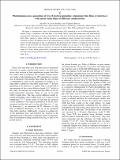| dc.contributor.author | Mei, Jun | |
| dc.contributor.author | Bradley, Michael Scott | |
| dc.contributor.author | Bulovic, Vladimir | |
| dc.date.accessioned | 2010-02-05T13:56:41Z | |
| dc.date.available | 2010-02-05T13:56:41Z | |
| dc.date.issued | 2009-06 | |
| dc.date.submitted | 2009-05 | |
| dc.identifier.issn | 1550-235X | |
| dc.identifier.issn | 1098-0121 | |
| dc.identifier.uri | http://hdl.handle.net/1721.1/51363 | |
| dc.description.abstract | We report a comprehensive study of photoluminescence (PL) quenching of tris-(8-hydroxyquinoline) aluminum (Alq[subscript ]3) at interfaces with thin films of tin oxide (SnO[subscript 2]) using both steady-state and time-resolved measurements. Quenching of excitons generated in the Alq3 layer increased with increased conductivity of the SnO[subscript 2] films, which we relate with the presence of nonradiative energy transfer from excitons in Alq[subscript 3] to transitions in SnO[subscript 2]. In addition, due to the semitransparency of SnO[subscript 2], the effects of optical interference on the steady-state PL quenching of Alq[subscript 3] are determined. We demonstrate that without accounting for the interference effects in the excitation, the extracted exciton diffusion length (L[subscript d]) in Alq3 is in the range of 10–20 nm. However, when using a numerical model to account for the optical interference effects, we find that L[subscript d] is in the range of 5–9 nm, which agrees with L[subscript d] extracted from time-resolved measurements (4–6 nm). We conclude that time-resolved measurements are least affected by optical interference, yielding the most accurate measurement of L[subscript d]. | en |
| dc.description.sponsorship | Department of Defense | en |
| dc.description.sponsorship | National Science Foundation | en |
| dc.description.sponsorship | Institute for Soldier Nanotechnologies | en |
| dc.language.iso | en_US | |
| dc.publisher | American Physical Society | en |
| dc.relation.isversionof | http://dx.doi.org/10.1103/PhysRevB.79.235205 | en |
| dc.rights | Article is made available in accordance with the publisher's policy and may be subject to US copyright law. Please refer to the publisher's site for terms of use. | en |
| dc.source | APS | en |
| dc.title | Photoluminescence quenching of tris-(8-hydroxyquinoline) aluminum thin films at interfaces with metal oxide films of different conductivities | en |
| dc.type | Article | en |
| dc.identifier.citation | Mei, Jun , M. Scott Bradley, and Vladimir Bulovic. “Photoluminescence quenching of tris-(8-hydroxyquinoline) aluminum thin films at interfaces with metal oxide films of different conductivities.” Physical Review B 79.23 (2009): 235205. (C) 2010 The American Physical Society. | en |
| dc.contributor.department | Lincoln Laboratory | en_US |
| dc.contributor.department | Massachusetts Institute of Technology. Department of Electrical Engineering and Computer Science | en_US |
| dc.contributor.department | Massachusetts Institute of Technology. Research Laboratory of Electronics | en_US |
| dc.contributor.approver | Bulovic, Vladimir | |
| dc.contributor.mitauthor | Mei, Jun | |
| dc.contributor.mitauthor | Bradley, Michael Scott | |
| dc.contributor.mitauthor | Bulovic, Vladimir | |
| dc.relation.journal | Physical Review B | en |
| dc.eprint.version | Final published version | en |
| dc.type.uri | http://purl.org/eprint/type/JournalArticle | en |
| eprint.status | http://purl.org/eprint/status/PeerReviewed | en |
| eprint.grantNumber | DMR 02-13282 | en |
| eprint.grantNumber | W911NF-07-D-0004 | en |
| dspace.orderedauthors | Mei, Jun; Bradley, M.; Bulović, Vladimir | en |
| dc.identifier.orcid | https://orcid.org/0000-0002-0960-2580 | |
| mit.license | PUBLISHER_POLICY | en |
| mit.metadata.status | Complete | |
